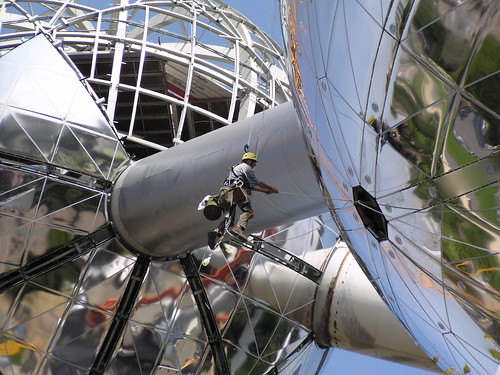Shearing Layers of Stuff
One of my favourite concepts for thinking about architecture is the idea of shearing layers. The term was coined by Frank Duffy and popularized by Stewart Brand. The core idea is that a building—properly conceived—isn't a single entity but a series of layers of with different life spans.
 photo credit: e³°°°
photo credit: e³°°°
Architecture
The site of a building changes on a geological time scale. The core structural elements may last for decades or centuries. The exterior for a decade or two. The services (wiring, HVAC, plumbing) for fifteen years. The layout could change every few years in a commercial space as walls are moved and changed according to the needs of commerce or the org chart. At the bottom layer, the stuff that sits in an office consists of things like desks and computers that get moved around monthly, weekly, or daily.The big risk with shearing layers is that if you misapprehend on which layer a component belongs, you end up with a building that's extremely difficult to use. Embed your clever new HVAC system in the structure and you could find yourself tearing down a whole building because air regulations changed.This is a lot of why I'm skeptical of projects like Cisco's City in a Box, being implemented in New Songdo.
The project calls for wired everything - an urban center where networking technology is embedded into buildings from the ground up and every home, school and government agency is equipped with sophisticated Telepresence video technology - what in Cisco mantra is called Smart+Connected Communities.
Cisco Wires City in a Box News ObserverThe only thing we can say for sure about the City in a Box is that its sophisticated telepresence technology will be laughingly inadequate long before the foundations need replacing. I hope they are building with that in mind.
 photo credit: pictureTYOShearing layers are hard to get right. Witness the Nankin Capsule Tower. It was specifically designed to withstand the problem of varying rates of change by having replaceable living components attached to a permanent core. The capsules were to be updated as technology and style demanded. They never were. Today, there are concerns about asbestos and earthquake readiness. The whole thing is slated for destruction, a mere 40 years after it was built.
photo credit: pictureTYOShearing layers are hard to get right. Witness the Nankin Capsule Tower. It was specifically designed to withstand the problem of varying rates of change by having replaceable living components attached to a permanent core. The capsules were to be updated as technology and style demanded. They never were. Today, there are concerns about asbestos and earthquake readiness. The whole thing is slated for destruction, a mere 40 years after it was built.
Software
The shearing layer problem becomes incredibly acute when you start building structures with software in mind. Software doesn't simply add a speedy layer to what's come before, it can fundamentally reshuffle the layers where features belong.Networking infrastructure sure looks and feels like a service (life expectancy 7-15 years), but standards change much more quickly than that. In the past decade, more than one innovative building project started by running kilometres of Cat 5 cable though the walls only to find that wireless routers had all but eliminated the need for ethernet jacks before construction was finished.Things get trickier when you want to build in sensors and responsive systems to smart buildings or when you want structures that can be shaped and reconfigured by subsystems and cybernetics. The speed of software is cruel and unrelenting. A structure built for durability must have an upgrade plan for its disposable components. Layers are tightly coupled at the creator's peril.
 photo credit: theqspeaks
photo credit: theqspeaks
Furniture
At this year's CES, a parade of television manufacturers seemed intent on getting a taste of that peril for themselves by bundling suites of applications with their offerings. Gizmodo's John Herman saw the problem immediately.
All that stuff is ephemeral, and mostly disposable. The little computers inhabiting new TVs live in a part of the tech world that moves at a different speed, where hardware and software are born and die in the span of a couple of years. Think of it this way: The HDTV you bought four years ago probably still looks great. The smartphone you bought four years ago lives in a landfill, next to the netbook you bought in 2008.
John Hermann I just want a dumb TV GizmodoHe goes on to propose a solution.
Just buy dumb TVs. Buy TVs with perfect pictures, nice speakers and an attractive finish. Let set top boxes or Blu-ray players or Apple TVs take care of all the amazing connectivity and content afforded to us by today's best internet TVs. Spend money on what you know you'll still want in a few years—a good screen—and let your A/V cabinet host the changing cast of disposable accessories.
John Hermann I just want a dumb TV GizmodoSnarkmarket's Robin Sloan approves.
I love the exhortation: Make them dumber! Yes, we want stuff that’s even dumber and more durable and more flexible. We want stuff we can plug into other stuff forever.It does seem true that in the places where requirements are clear—this must make a good picture—and interfaces consistent, things you buy can actually find their footing and hold steady in the swirl of the shiny new.I'd love a directory of these steadfast components.
Robin Sloan All hail the humble component SnarkmarketI keep thinking of Ed Norton's character's lament in Fight Club after his condo gets blown up. "When you buy furniture, you tell yourself, that's it. That's the last sofa I'll need. Whatever happens, that sofa problem is handled."These are shearing layers in the living room. TVs move at the speed of furniture, set top boxes move at the speed of gadgets. The hope here is that as rational consumers we ought to be able to work out whether whatever we're purchasing has been built with the right rate of change in mind and whether it's free of coupling with speedier or slower components. To fail in this task it to end up with an object hopelessly doomed to partial obsolescence or an early trip to the landfill.
Trash
I struggle with the shearing layer problem every time I make a significant purchase. In theory I'd be better off getting things that will last and last, but more than once, life events have resulted in me shedding most or all of the large things that I owned. I may not be settled enough to have and to hold enduring objects. My personal shearing layers don't line up with the life expectancy of the products.
 photo credit: FurryscalyThe people over at Cool Tools seem to be maintaining the directory that Robin wants, but there are issues. First, what if someone invents a better version of the device that you've carefully selected to last a lifetime? This would not be an unexpected development. Second, though we might try to cull our possessions for simplicity of function, it's hard to predict where the next Cambrian explosion of innovation will occur. Seemingly sanely coupled functions can suddenly become uncoupled. Third, separate things out too much and you risk a life of perpetual systems administration as you try to stay on top of whether the various bits will all talk to each other properly.This is where spimes are meant to step in and solve problems. If objects are easily made—and sanely disposed of—issues around predicting the longevity of a thing go away. Objects made of some imaginary suite of ultra-reconfigurable materials remove the shearing layer problem by allowing (forcing?) everything to move at the same speed. Your TV connection suite's out of date? Pulp it and we'll fab a new one with the right dongles and ports.Assuming, that is, that we end up with spimey materials that are developed with cradle to grave principles in mind.
photo credit: FurryscalyThe people over at Cool Tools seem to be maintaining the directory that Robin wants, but there are issues. First, what if someone invents a better version of the device that you've carefully selected to last a lifetime? This would not be an unexpected development. Second, though we might try to cull our possessions for simplicity of function, it's hard to predict where the next Cambrian explosion of innovation will occur. Seemingly sanely coupled functions can suddenly become uncoupled. Third, separate things out too much and you risk a life of perpetual systems administration as you try to stay on top of whether the various bits will all talk to each other properly.This is where spimes are meant to step in and solve problems. If objects are easily made—and sanely disposed of—issues around predicting the longevity of a thing go away. Objects made of some imaginary suite of ultra-reconfigurable materials remove the shearing layer problem by allowing (forcing?) everything to move at the same speed. Your TV connection suite's out of date? Pulp it and we'll fab a new one with the right dongles and ports.Assuming, that is, that we end up with spimey materials that are developed with cradle to grave principles in mind.
What can I do with all that leftover plastic, can I recycle it‽One day, yes!
Makerbot Industries Wiki Plastic Recycling
 photo credit: mbeo
photo credit: mbeo